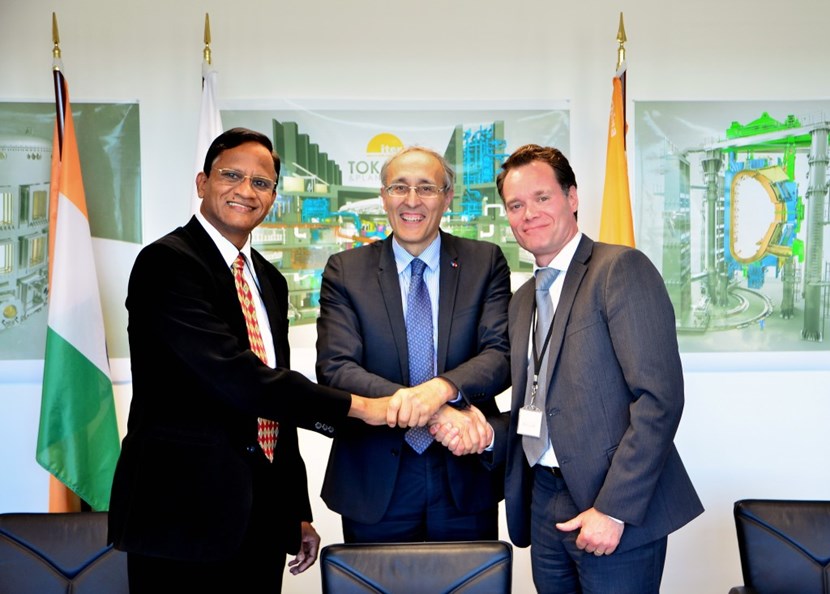ITER NEWSLINE
-
Indian and French companies will manufacture port plug structures
Victor Udintsev for the Port Plugs & Diagnostics Integration Division
Indian and French companies will manufacture port plug structures
A key ally to the research program at ITER is the high-performance monitoring of the plasma and the first-wall of the blanket during operation. A large number of diagnostics are planned to measure plasma temperature, density, radiative properties, first-wall resilience, and many other characteristics from vantage points all around the vacuum vessel.

On 28 October, the contract for the manufacturing, qualification, testing and supply of the common port plug was awarded by the ITER Organization to a consortium formed by CNIM (France) and Larsen & Toubro (India). Pictured with ITER Director-General Bernard Bigot is Anil Parab, Senior Vice-President of Larsen & Toubro Heavy Engineering, and Ludovic Vandendriesche, Vice President of Nuclear & Big Science/CNIM Industrial Systems.
The port-based diagnostic systems will be housed in
generic port plugs that will provide a common platform, or container, for a variety of diagnostics. In addition to their role as structural "host" to the systems, the port plug structures must also contribute to nuclear shielding by "plugging" the opening of the port. Water will also circulate in the plugs for cooling during operation and for heating during
bakeout.
Port plug structures are designed to survive the lifetime of ITER, calculated as 20 years, some 30,000 discharges, and an estimated 3,000 disruptive events. These bus-size components are slightly larger at the upper port level (6 x 1.5 x 1.5 metres) than at equatorial level (2.9 x 1.9 x 2.4 metres). The structure of the equatorial port plug alone weighs about 15 tonnes—a figure that increases to 45 tonnes when the component is fully integrated with shielding modules and
diagnostic first walls. The design of port plug structures was developed in close collaboration with technical teams in the Domestic Agencies and with interfacing responsible officers at ITER.
Following the adoption of a common approach to the manufacture of the 22 diagnostic port plug structures, the technical specifications were finalized and the call for tender launched. On 28 October, the contract for the manufacturing, qualification, testing and supply of the common port plug was awarded by the ITER Organization to a consortium formed by CNIM (France) and Larsen & Toubro (India).
The first port plug structures will be manufactured in the next three years and will be shipped to Russia and to China for the integration of the first plasma ports, namely equatorial ports 11 and 12.
return to the latest published articles







